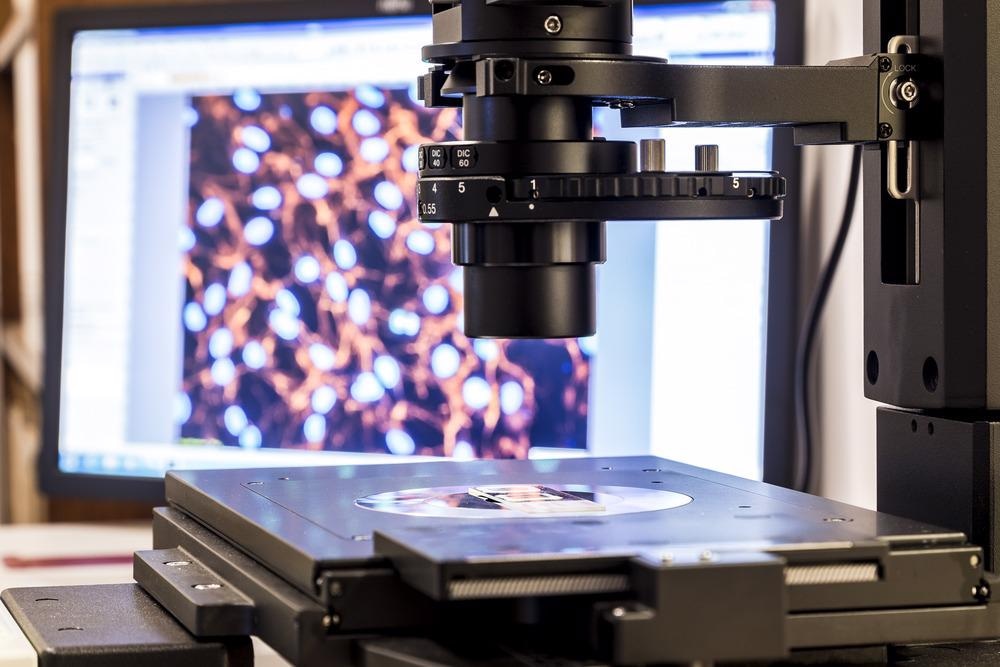Researchers at Kanazawa University, Japan, recently created a new ultrafast amplitude detector to enable even greater temporal resolution for high-speed atomic force microscopy. Their paper, published in Applied Physics Letters in 2021, may form part of the foundation for a faster atomic force microscope that would enable non-destructive inspection of fast, dynamic, biomolecular processes and events.

Image Credit: dominika zara/Shutterstock.com
How to Make High-Speed Atomic Force Microscopy Even Faster
In atomic force microscopy (AFM), a tiny needle-like probe is scraped over a surface’s sample. The small tip is connected to a cantilever so that it moves away from the surface due to atomic force reactions that occur at distances of just a few microns or less.
An AFM device includes a delicate sensor to precisely record the motion of the cantilever. This recording reveals information about the surface structure of the sample, as well as micron-scale processes and events taking place at the surface.
This process is more complicated for high-speed AFM (HS-AFM). In HS-AFM, the cantilever oscillates near its resonance frequency before moving the tip to the surface. As the tip scrapes over the sample, the oscillation varies in terms of amplitude due to interactions between the tip and the sample’s surface.
This means that the HS-AFM scan can take place much more quickly. HS-AFM has been used to analyze dynamic processes taking place on sample surfaces, such as the molecular dynamics of the human flu virus which were characterized using the technique in 2020.
HS-AFM is a new technique, but researchers at Kanazawa University are already trying to improve it. They noted that the main bottleneck to even faster HS-AFM is the intrinsic slowness of amplitude variation detectors currently available. This slowness, referred to as latency, is caused by the finite time interval required to detect a change in amplitude. Researchers targeted amplitude latency to pave the way for even faster HS-AFM in the near future.
What is the Need for Speed in AFM?
Visualizing and recording tiny dynamic processes inside living cells is important if we want to learn more about them. These biomolecular processes govern biological phenomena such as disease and illness, and understanding them in greater detail may unlock lifesaving research in the future.
In the short time that it has been around, HS-AFM has already been established as an important technique for observing biological processes on the sub-molecular spatial scale in real-time, and with sub-second temporal resolution. However, many important processes such as ion transport motion or signaling mechanisms in membranes happen too fast to be captured by standard HS-AFM.
The new ultrafast amplitude detector developed by Kanazawa University researchers promises to significantly improve the temporal resolution of HS-AFM.
This research came from the university’s Nano Life Science Institute (NanoLSI), a research center established in 2017 to combine developments in bio-scanning probe microscopy and create new nano-endoscopic techniques to image, analyze, and manipulate biomolecules.
The institute’s focus has been on developing technologies and methods that will enable us to see biological processes taking place at temporal and spatial resolutions that conventional microscopy cannot achieve.
New Ultrafast Amplitude Detector
The new detector was designed to ensure zero intrinsic latency in amplitude detection for HS-AFM. The researchers created a differential-based (DB) detection algorithm that makes a trigonometric calculation using the differential operation to remove latency.
The calculation of A2 = A2(sin2ωct + cos2ωct) = (Asinωct)2 + (Acosωct)2 is performed with an incoming sine wave from the amplitude detector Asinωct. This differential operation gives the cosine wave Acosωct by the differential operation.
Using this algorithmic architecture, the researchers built a test circuit that could perform at between 300 and 1500 kHz carrier frequency. This new DB amplitude detector worked around ten times as quickly as HS-AFM techniques employed today.
The new detector was tested in a real HS-AFM experiment and reported in the recent paper. In that experiment, scientists characterized actin filaments, a cytoskeletal filament found in eukaryotic cells. A scanning velocity of 800 micrometers per second, four times faster than typical HS-AFM processes, was achieved with the new method.
As well as recording at a higher video frame rate (50,000 frames per second), the technique was also less invasive. Standard HS-AFM experiments with actin filaments cause the filament to collapse after just one second. With the new detector, scientists could hold the biomolecule stable and observe it for 30 seconds.
Next Steps for HS-AFM
The new ultrafast amplitude detector developed in this research will lead to faster imaging speed and less invasive imaging compared to standard HS-AFM. This will enable scientists to study sub-molecular biofunctional dynamic processes that play a central role in the life sciences.
For HS-AFM to achieve its full potential as an ultrafast, ultra-sensitive, real-time imaging and analysis technique, more developments will be needed. Researchers at Kanazawa University and other institutions will now turn their attention to improving the scanner and cantilever’s speed performance to complement this latest breakthrough with ultrafast amplitude detectors.
References and Further Reading
Hiromoto-Yamaki, N., et al. (2014) Ultrafast Diffusion of a Fluorescent Cholesterol Analog in Compartmentalized Plasma Membranes. Traffic. https://doi.org/10.1111/tra.12163.
Kanazawa University research: Speeding up atomic force microscopy. (2021) PRNewswire. [Online] Available at: https://www.prnewswire.co.uk/news-releases/kanazawa-university-research-speeding-up-atomic-force-microscopy-854179373.html.
Lim, K. et al. (2020). High-Speed AFM Reveals Molecular Dynamics of Human Influenza A Hemagglutinin and Its Interaction with Exosomes. Nano Letters. https://doi.org/10.1021/acs.nanolett.0c01755
Miyagi, A., and S. Scheuring (2018). A novel phase-shift-based amplitude detector for a high-speed atomic force microscope. Review of Scientific Instruments. https://doi.org/10.1063/1.5038095.
Umeda, K., et al. (2021). Architecture of zero-latency ultrafast amplitude detector for high-speed atomic force microscopy. Applied Physics Letters. https://doi.org/10.1063/5.0067224.
Disclaimer: The views expressed here are those of the author expressed in their private capacity and do not necessarily represent the views of AZoM.com Limited T/A AZoNetwork the owner and operator of this website. This disclaimer forms part of the Terms and conditions of use of this website.